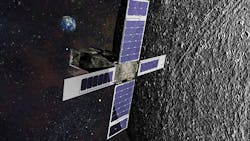Lockheed Martin’s new infrared technology on SkyFire CubeSat to explore lunar surface
DENVER, 11 Aug. 2016. NASA scientists plan to use new infrared technology from Lockheed Martin (NYSE:LMT) engineers in Denver, Colorado, to explore the mysteries of the moon and “illuminate the unknown.” Lockheed Martin won a NASA contract to deploy SkyFire, a 6U CubeSat planned to launch to the moon in 2018 with Orion's Exploration Mission-1 (EM-1).
The infrared camera will take high-quality images with a lighter, simpler unit. This reduction in mass means lower payload cost and easier maneuverability in space.
"The CubeSat will look for specific lunar characteristics like solar illumination areas," explains James Russell, Lockheed Martin SkyFire principal investigator. "We'll be able to see new things with sensors that are less costly to make and send to space."
"SkyFire's lunar flyby will pioneer brand new infrared technology, enabling scientists to fill strategic gaps in lunar knowledge that have implications for future human space exploration," says John Ringelberg, Lockheed Martin's SkyFire project manager. "Partnering with NASA for another element of the Orion and Space Launch System EM-1 flight is very exciting."
The moon is just the proving ground for this new technology. If successful, the infrared system on SkyFire could eventually be used for cost-effective studies of a planet's resources before humans arrive, including: analyzing soil conditions, determining ideal landing sites, and discovering a planet's most livable areas.
"For a small CubeSat, SkyFire has a chance to make a big impact on future planetary space missions," Russell adds. "With less mass and better instruments, we can get closer, explore deeper, and learn more about the far reaches of our solar system."
As part of NASA's Next Space Technologies for Exploration Partnerships (NextSTEP) program, SkyFire will ride to the moon with 12 other CubeSats on EM-1.
SkyFire is a public-private partnership between Lockheed Martin and NASA. Lockheed Martin will build the satellite with internal investments, and the newly-signed contract will grant Lockheed Martin access to send the satellite to the moon aboard the EM-1 launch. NASA will, in turn, receive data from the mission. The Lockheed Martin development team primarily consists of early-career engineers in partnership with the University of Colorado Boulder.
Headquartered in Bethesda, Maryland, Lockheed Martin is a global security and aerospace company that employs approximately 125,000 people worldwide and is principally engaged in the research, design, development, manufacture, integration, and sustainment of advanced technology systems, products, and services.
Search the Aerospace & Defense Buyer's Guide
You might also like:
Subscribe today to receive all the latest aerospace technology and engineering news, delivered directly to your e-mail inbox twice a week (Tuesdays and Thursdays). Sign upfor your free subscription to the Intelligent Inbox e-newsletter at http://www.intelligent-aerospace.com/subscribe.html.
Connect with Intelligent Aerospace on social media: Twitter (@IntelligentAero), LinkedIn,Google+, and Instagram.
Intelligent Aerospace
Global Aerospace Technology NetworkIntelligent Aerospace, the global aerospace technology network, reports on the latest tools, technologies, and trends of vital importance to aerospace professionals involved in air traffic control, airport operations, satellites and space, and commercial and military avionics on fixed-wing, rotor-wing, and unmanned aircraft throughout the world.


